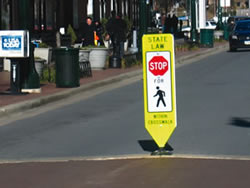Ask Strong Towns, Question #2
We invite our members to submit their questions on anything that they would like our thoughts on. We’ll give you a Strong Towns answer or find an expert who can. This week’s question is submitted by Jeff G.
I'm working with several communities which are struggling with how to do "visioning" for Strong Towns. Can you provide any useful references?
In general, I think that cities are pretty much “visioned” out. The planning profession has spent decades getting people together with sticker charts and, more recently, fancy gadgets to try and build consensus around policy changes. This is consistent with an approach that is more worried about process than results, which notoriously rarely materialize. When "successful" it tends to produce a watered-down consensus around one or two big initiatives instead of what is drastically needed in most cities today: a commitment to try many small things and build on success. (Note that I worked on these kind of projects for a decade so any stones I’m throwing should hit me to some degree as well.)
If I had to describe “visioning” in a Strong Towns sense, it would look a lot more like doing. It would certainly be small scale and involve more time out on the street than sitting in a meeting.
As an example, on a recent trip to Sheridan, Wyoming, I was able to spend some time walking around town with their redevelopment staff. They were showing me their community, but then I started showing it to them in a different way. We started talking about the pattern of the neighborhood, how the buildings and the public realm interact, how those interactions could be strengthened.
 By the time we had walked a few blocks, they had a list of small things to do to improve the neighborhood. These were things like painting crosswalks, planting trees, moving benches and putting out sandwich board pedestrian signs where the street was difficult to cross. We also talked about the steps beyond that, like changing development codes and modifying street reconstruction standards. I was, in a sense, teaching them how to do visioning on-the-fly on a block by block basis.
By the time we had walked a few blocks, they had a list of small things to do to improve the neighborhood. These were things like painting crosswalks, planting trees, moving benches and putting out sandwich board pedestrian signs where the street was difficult to cross. We also talked about the steps beyond that, like changing development codes and modifying street reconstruction standards. I was, in a sense, teaching them how to do visioning on-the-fly on a block by block basis.
Is this really visioning? In the American Planning Association sense, not really. We didn’t have a public meeting with doughnuts and coffee, we didn’t treat every opinion as superficially equal and valid and we didn’t have a formal report the community could use to apply for grants with. I’m okay with that – I’m sure Sheridan has all those things and they are not helping. What we did there was probably more triage than visioning – in the modern sense – but really, that is where our communities are at right now.
So what are some resources for this? One that we put together is our Neighborhoods First report. While it isn’t a “how to” manual (we’re working on that), it will give you a good sense of the process we went through to experiment, observe and then repeat within one distressed neighborhood. If you can follow this approach, you will be doing many small scale projects each year. Where you have success, you now have something to build on and scale to other places. Where you have failures, you learn valuable information at a small and relatively inexpensive scale.
The Street Plans Collaborative has a free manual on Tactical Urbanism that goes through the approach and provides a list of projects they have tried out. You can also find some regular inspiration from the blog at The Better Block or just watch Jason Roberts’ TED talk.
Helping people see things differently – to train people to see their community from outside of an automobile – is what SID.tv is all about. We want to try and give you an eye for how to do this stuff. Much of my inspiration for this comes from stuff I picked up hanging out with the brilliant architects, planners and urban designers that annually attend the Congress for the New Urbanism. This year they are in Buffalo (I’ll be there too).
Some books that will help you analyze the city block by block include:
- A Pattern Language by Christopher Alexander
- Close Up: How to read the American City by Grady Clay
- Suburban Nation by Duany, Plater-Zyberk and Speck
I also have a copy here of Street Design: The Secret to Great Cities and Towns by Victor Dover and John Massengale. I’ve not made my way through it just yet but I have a great amount of respect for their work and am confident the book contains a lot of helpful stuff.
Now while all of this has been rather anti-visioning in terms of how planners tend to approach things, I will finish by saying that there is still room for the great plan in a Strong Towns discussion. Such a plan, however, will be large scale, aspirational and focus primarily on the physical form that the community can work towards. It would not try and plan out the next twenty years of road improvements, infrastructure extensions and zoning and all the other things that our current planning paradigm obsesses over (in order to keep planners and engineers employed).
You can become a member of Strong Towns, and ask your question today, by going to our membership site.
